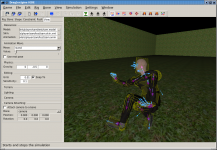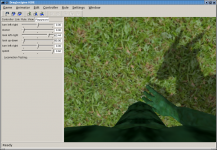After all the Drag[en]gine is supposed to be useful for all kinds of people interested in game development hence quite some time has been and will be spent on providing an easy to use yet powerful game engine and editing tools. To achieve this goal a new tool has been put in place: the DE-IGDE. But first things first.
Game Engine
On the game engine front changes have been made to the world/scene system. Up to now for creating a game a developer had to create a world populating it with scenes which represented evenly spaced clusters of space in the world. This has been done to cope with the precision problem that any game with a large world afflicts. This system has though been cumbersome to use for both the game developer as well as the module authors. Hence a change has been made especially looking at the increase of 64-bit systems. The scene objects have been dropped altogether. All kinds of elements are now added to the world object directly. For the position 'double' precision values are now used. Using this new system a possible world size of up to 1mio km is possible with a precision of 1um. For comparison the earth has roughly a circumference of 40'000km and even the largest game worlds so far did not remotely scratch on these numbers. There's enough space left for even the largest game worlds if required without sacrificing precision while keeping things simple.
Another change happened on the animator system. The existing system lacked some flexibility and could become a bit cumbersome to use in complex animation scenarios. To account for this the system has been reworked and new elements added. Now links and targets can be used which provide a more fine grained control over the mixing of rules. Furthermore a new animator rule has been added which stems from movie CG too, the foreign state rule. This rule allows to copy and modify bone states. The Wiki has been updated with informations about the animator system.
On the physics side the touch sensors have been extended with more functionality. They are very useful for various purposes ranging from ground detection to sensing objects entering and leaving areas. Using touch sensors instead of testing for collisions on your own has a couple of advantages. You can either just listen for enter/leave notifications ( useful for passive sensing like for example triggers ) or test the touched content for collision ( useful for actively testing what occupies a given slab of space ). Since you can test this way only a small set of objects it is fast allowing to do more collision queries for improved AI. The Wiki contains now informations about sensors.
Last but not least the game engine switched license to the L-GPL. This has been done to avoid potential license traps and to allow a wider usage of this game engine for free and commercial usage.
IGDE
As mentioned in the introduction to this news post the editing tools received a major overhaul. To increase productivity with the Drag[en]gine the existing editors have been fusioned together into the IGDE: The Drag[en]gine Integrated Game Development Environment. The IGDE is now the one-stop solution to create games with the Drag[en]gine ( except using Blender or GIMP or other tools for working with specific assets like images or modeling ). Going with the philosophy of the Drag[en]gine the IGDE is also build in a modular fashion. Editors are simply modules loaded into the IGDE and can be extended, added and modified without harming each other. So far the rig editor, animator editor and world editor module are included in the IGDE. Many more will follow since the editor framework is now streamlined and new editors can be quickly created and added. The editor modules can communicate with each other and the IGDE hence it is not just a collection of editors.
Both the editors received improvements alongside the implementation of the IGDE. The rig editor has now better display of bones, shapes and constraints ( more worked on ). The world editor received a new painting mode to paint holes on height map terrains to allow shafts down into the ground as well as cave systems connecting straight to the surface. The animator editor received a playground to conveniently test created animators. In addition a locomotion testing system has been added which simulates to some extend the typical FPS movement manipulating controllers using the mouse and keyboard ( you can assign controllers to different locomotion attributes for testing ). The animation result can be different than in the game depending on how you use animators. All editors have been modified to have now the same look and feel.
Screenshots
A lot of screenshots have been added of the reworked editors including the IGDE. Here only two of the entire 9 images. Find the rest in the gallery.
I also tried to record a video of the locomotion testing system in the animator editor. Since I could not find an application able to capture both the editor window and the OpenGL output inside I had to resort to a CamCorder. I'm having though troubles to upload the video here so no link to it yet. Watch out for the addition of the video ( it will notify you ) once I managed to pull it off.
Outlook
The upcoming steps now are: improving on the IGDE, adding new editors, fixing some physics issues and adding engine features not implemented yet.
There has been also work on the Epsylon game which will be though shown in an own news post some time later ( since we have manners and are no front-page hoggers ).



![Drag[en]gine](https://media.indiedb.com/cache/images/engines/1/1/9/crop_120x90/banner_large.png)
